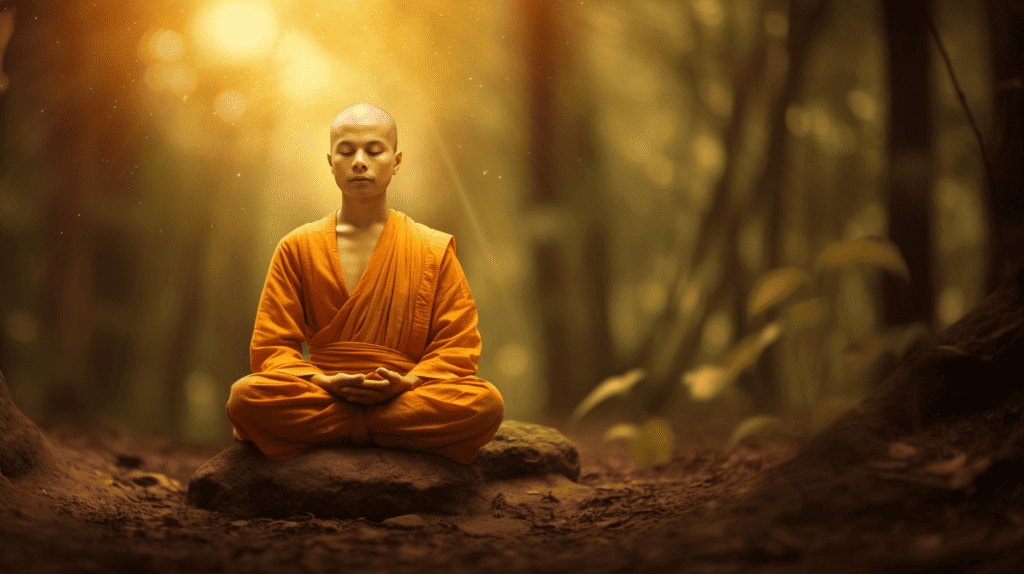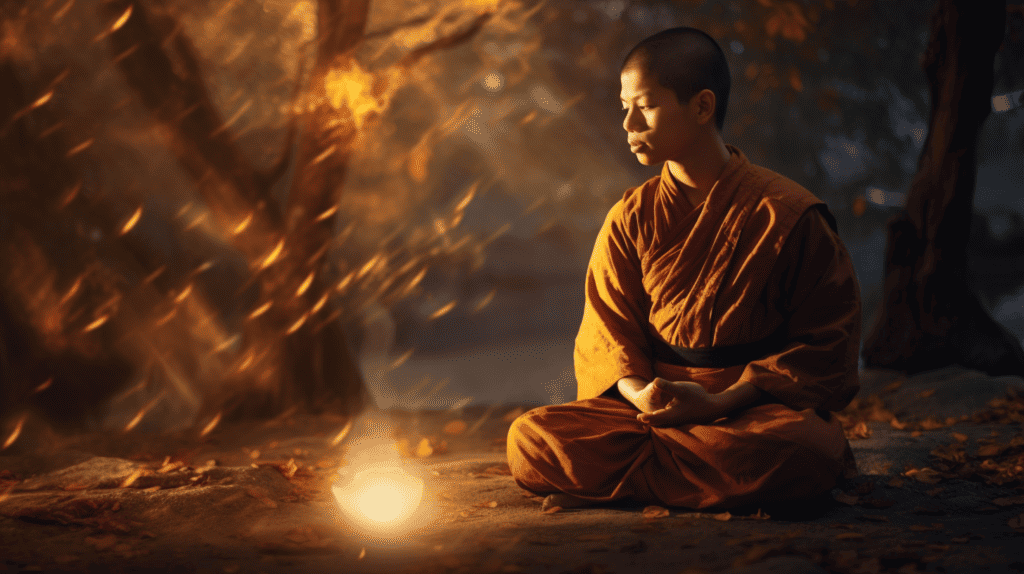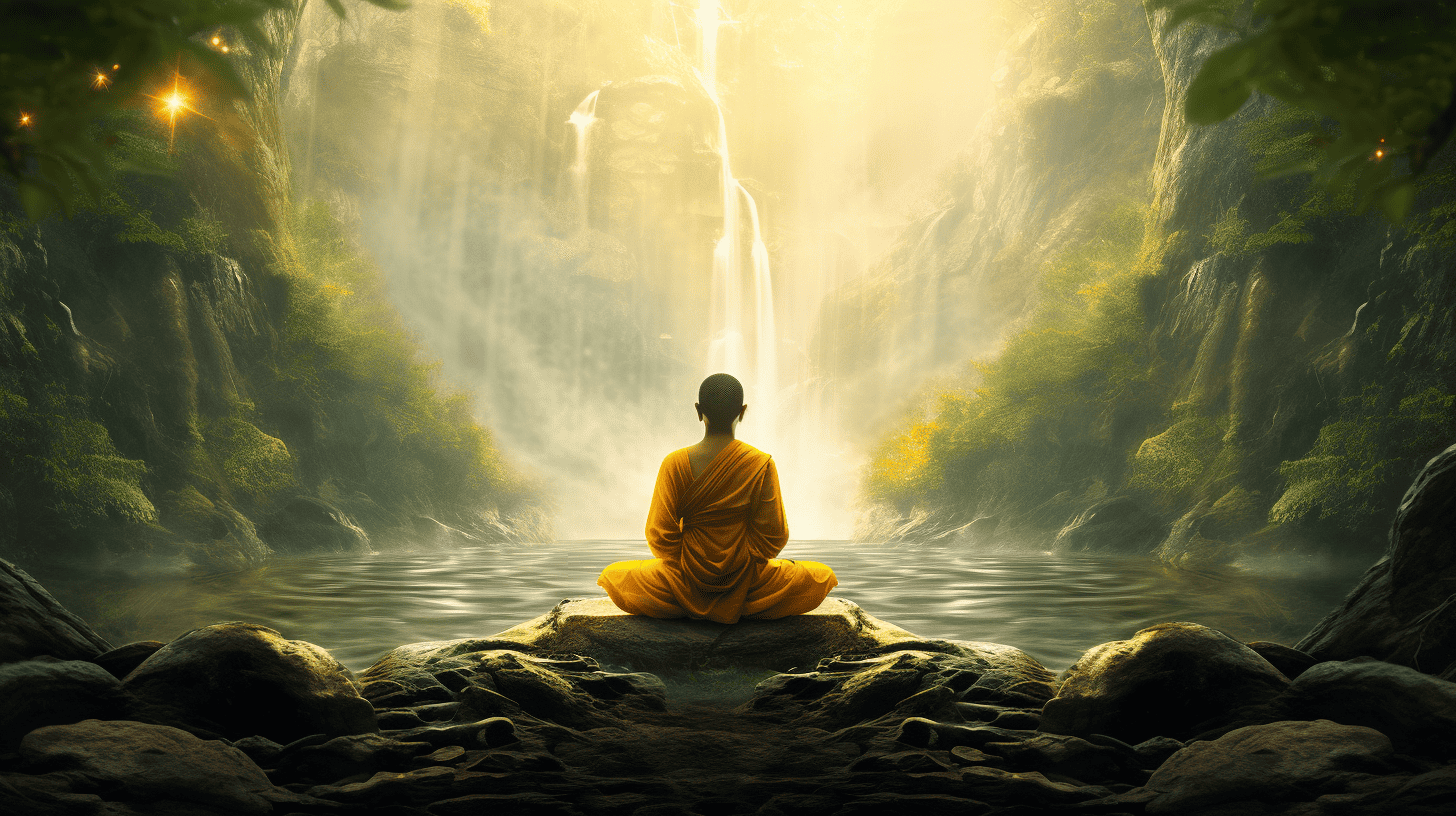I’d like to welcome you on a journey into Buddhist meditation techniques for beginners. Whether you’re completely new to meditation or have dabbled before but aren’t quite sure where to start, this guide aims to equip you with a solid foundation for developing your own meditation practice using timeless insights from the Buddha and Buddhist tradition.
Key Takeaways:
- Meditation helps reduce stress and brings other scientifically validated benefits
- The Buddha taught mindfulness meditation to understand reality and end suffering deeply
- It’s simple to start – just focus on the breath, body sensations or walking
- Over time you can add techniques like mantras, visualizations or meeting places
- Create a regular home practice and join a community for ongoing support
- Apps like Calm and InsightTimer provide guided meditations
- Discovering inner stillness and wisdom is a gradual path well worth taking step-by-step
5 Easy Buddhist Meditations for Beginners
Starting a meditation practice can feel intimidating, but it doesn’t have to be hard. Here are 5 easy forms of meditation suitable for beginners:
Learning to Breathe: Anapanasati Meditation
This fundamental Buddhist meditation technique simply involves focusing your attention on your breathing.
To begin, find a quiet place to sit comfortably. Keep your back straight but not rigid, with your hands resting gently in your lap. Close your eyes if you feel comfortable doing so.
Bring your full awareness to the sensations of each inhale and exhale. Pay attention to wherever you feel the breath most distinctly, such as the rise and fall of your abdomen or the air passing through your nostrils.
When your mind wanders, gently return your focus back to the breath.
Aim to meditate for 5-10 minutes to start. Over time, you can lengthen your practice. Remember that meditating even 5 minutes each day can make a meaningful difference.
Shambhala Publications: Make meditation a priority and try to develop it as a daily habit. It’s important to have a plan to overcome the challenges of integrating meditation into your busy life.
Tip: There’s no need to control your breath. Just relax and observe.
Sitting in Stillness: Shamatha Meditation
Shamatha (calm abiding) meditation comes from the Tibetan Buddhist tradition.
Simply sit comfortably with good posture and turn your attention gently inward, cultivating tranquility with an unwavering, present moment awareness of whatever thoughts or sensations arise, without judgment or attachment.
Allow everything to be just as it is. Let go of any striving. As the minutes pass, a sense of inner peace, stillness and silence naturally arises.
Over time, Shamatha meditation helps develop concentration while uprooting our conditioned patterns of thinking and negative mental states.
Walking Meditation: Mindfulness in Motion
Not in the mood to sit still? Walking meditation allows you to integrate mindfulness into your everyday motions.
Find a quiet place you can walk 10-20 steps back & forth. Stand still for a minute with your weight evenly balanced and hands by your sides.
Slowly lift one foot, move it forward deliberately while noticing the shifting sensations in your foot and leg. Fully feel your heel, then ball of foot, then toes lightly touch the ground.
Repeat slowly with your other foot, keeping your full attention on the process of walking. Move gently, not robotically. Allow awareness of sensations, sounds, thoughts and feelings without judgment.
Let go of reaching any particular destination — it’s all about being fully present with each step.
Mantra Meditation 101
A “mantra” is a word or phrase repeated to oneself in meditation as an object of focus and means to calm the chatter of thoughts.
Common mantras in Buddhist traditions invoke qualities like loving kindness, compassion, peace, or mindfulness. Examples include:
- Om mani padme hum
- Buddho or Buddham (remembering the Buddha)
- Metta (loving kindness)
To begin a simple mantra practice, sit comfortably and upright. Close your eyes and relax your body without sacrificing awareness. For a few minutes, focus completely on your breath.
When ready, start gently repeating your chosen mantra aloud or silently to yourself. Say the mantra continuously, letting it fill your mind. If thoughts intrude, just return to the mantra.
Cultivating Loving-Kindness: Metta Meditation
The practice of “metta” or loving-kindness meditation aims to cultivate unconditional, compassionate love towards oneself and all beings.
To start, sit comfortably with eyes closed or slightly open. Center yourself by watching your breath, in and out. Send yourself these intentions:
“May I be well, peaceful, and free from suffering.”
“May I care for my health and wellbeing.”
Visualize a gentle golden light extending from your heart center, filling your body with loving energy.
Next, call to mind loved ones, repeating: “May you be well, peaceful, and free from suffering.” Shine the warm light of loving-kindness towards them.
Over time, extend these heartfelt wishes out towards acquaintances, difficult people, and ultimately all beings everywhere without exception:
“May all beings be healthy, happy, and deeply cared for.”
The Basics of Mindfulness Meditation
The foundational practice the Buddha himself taught involves training our minds in mindfulness — maintaining moment-by-moment awareness of our ever-changing sensory experience without getting caught up in judgments and reactions.
Modern clinical and scientific research confirms meditation helps reduce stress, ease anxiety and depression, sharpen focus, and bring health benefits like lower blood pressure. But in the Buddhist tradition, mindfulness meditation serves a deeper purpose: Coming home to ourselves and waking up to our true nature beyond all labels and limitations.
The ultimate goal isn’t to get relaxed or reduce symptoms of distress, but rather to uproot the root causes of suffering by fully observing reality as it actually is here and now.
We meditate to see clearly — beyond biases, beliefs and assumptions — how everything arises, abides briefly, and passes away each moment according to causes and conditions. This clears the path to liberation.
Mindfulness meditation means paying attention, on purpose and without reaction, to whatever is happening within and around you. It means noticing thoughts, feelings, sounds, and sensations just as they are.
Set aside striving and judgments. Instead of frantically doing, schedule time simply to be. With patient, alert presence, the meditator watches the show of passing phenomena.
How to Start a Buddhist Daily Meditation Practice

Making meditation a consistent daily habit takes some effort but yields huge rewards. Follow these steps for getting started:
1. Designate a space. Set up a corner or small room in your home exclusively for practice. Keep it clean, quiet and sanctified. You could decorate with spiritual imagery, flowers, candles — objects evoking peacefulness.
2. Choose a regular time. Attach your session to an existing routine, like first thing after you wake up or before going to sleep. Meditating when your mind is calm and alert sets you up for the best sit.
3. Start small. Even 2-5 minutes of sincere practice makes a difference! Don’t overload yourself initially. Once you’ve anchored the habit, slowly increase your session duration.
4. Find supplies & props. Meditating on a cushion on the floor allows for a stable posture. Utilize a small altar, bell or singing bowl to enter and close your practice ritually. Set a timer so you don’t check clocks.
5. Just sit. Now begins the heart of it — showing up with patience and curiosity for your inner landscape. Observe without trying to manipulate your experience. Non-judging awareness lets things be as they are.
6. Connect with others. Getting involved with a local sangha (community) or meditation class provides invaluable live guidance and social support to stick with this deeply personal path.
Overcoming Obstacles in Your Practice
Launching and sustaining a meditation routine has its challenges. Try these approaches if you feel blocked:
Too Busy? Even 5 minutes makes a difference. Schedule meditation into your calendar, prioritizing it amidst other commitments. Rise early to practice before the busyness of your day unfolds.
Can’t Sit Still? Instead of forcing yourself into a pretzel, meditate in whatever posture your body cooperates with — even lying down! Movement-based practices like walking meditation or mindful yoga help restless bodies settle.
Bored or Restless Mind? Patience and persistence pass these phases. Experiment with different techniques like mantra recitation to anchor your attention when it wanders. Cultivating interest for what is arising here and now transforms practice from dull to vibrant.
Forget To Practice? Set cell phone alerts for your meditation time so you don’t space out. Post reminders by your meditation seat or devices to cue you. Establish rituals preparing for practice. Enlist any means necessary to re-member your commitment.
Too Discouraged? Our minds can beat us up with judgments like “I’ll never get this.” Meet self-criticism with compassion. Just as you would encourage a dear friend, remind yourself that beginning anything meaningful takes time and missteps — then let go and continue.
Establishing a Home Meditation Space

While technically you can meditate anywhere, creating a dedicated practice space helps ritualize entering this sacred time and clarifies your intention to temporarily set worldly concerns aside.
Choose a quiet, uncluttered area removed from household hubbub. Face a blank wall to avoid visual distractions. Dim lighting and soft fabrics make the energy more womblike and cocooning.
BuddhaNet: Follow the four Ps: place, posture, practice, and problems. Find a quiet place, maintain a comfortable posture, focus on your breath, and patiently return your attention to your breath when distractions or thoughts intrude.
Design your spot deliberately to evoke serenity. Play with incorporating special spiritual objects like altars, candles, singing bowls, imagery, flowers and art. I enjoy accenting my meditation corner with meaningful quotations to inspire presence.
This space tells your unconscious mind: Here we attune to peace within. Let go of doing; relax into non-striving being.
Apps and Timers for Guidance
While no software substitute exists for studying directly with a qualified meditation teacher, today’s apps and timers can provide helpful mentoring for establishing your practice:
InsightTimer — This popular free app includes thousands of guided meditations on every conceivable topic, from Deepak Chopra to Tara Brach. Browse meditations by theme or time duration. Save your favorites. Community discussion boards provide camaraderie with fellow meditators around the world.
Calm — This app for both iOS and Android offers simple well-designedguided meditations plus music/nature tracks to enhance your sit. Choose session lengths from 3-25 minutes. Save preferred meditations for quick access. Track milestones like total minutes meditated.
Dharma Seed — Discover free recorded dharma talks and guided meditations offered by monastics and dedicated lay practitioners from Theravada Buddhist lineages around the globe. New material added daily provides an endless wealth of support.
Meditation Timer Pro — If you just want a simple timer without instructions, this no-frills tool lets you set custom meditation durations from 1 second to days. Record sessions for review. Multiple sound options including bowls are available when time’s up.
Buddhism’s Noble Eightfold Path
The Buddha laid out this integrated developmental path — from Right Understanding and Intention to Right Concentration and beyond — as the way leading to the cessation of suffering.
While meditation offers profound benefits, lasting liberation teachings integrating conduct, concentration and insight. Study these eight factors to fully actualize the Buddhist path.
Discovering Your Buddha Nature
The spark of wakefulness within you, right here and now as you read these words — fresh, aware, luminous, free — that inner cognizance IS what the Buddhist teachings call Buddha Nature.
Meditation allows us to reunite with this already present wisdom essence. But no need to take my word for it — through sustained practice you’ll directly recognize your own awakened Mind.
The path is endless; there’s no rush to attain some enlightenment finish line. Let your meditation journey unfold here and now, at its own pace — one mindful breath at a time.
I wish you inspiration with cultivating tranquility and insight upon this Noble Eightfold Path!
FAQ on Buddhist Meditation Techniques for Beginners
Q: How can I start to practice Buddhist meditation as a beginner?
A: First, find a quiet and peaceful environment where you can concentrate without any distractions. Next, sit in a comfortable posture, keeping your back straight but not stiff. Close your eyes lightly and bring your focus to your breath. Try to notice each inhale and exhale without trying to modify it. It’s alright to have thoughts during the practice, but when you recognize them, gently bring your attention back to your breathing. You can also join a local meditation class or find a Buddhist teacher to guide you in your initial journey.
Q: Do I need to have a specific posture to meditate?
A: While there isn’t one ‘correct’ meditation posture, sitting in a comfortable position can be helpful for maintaining concentration during the meditation. This can take the form of sitting on a cushion, on a chair, or even lying down. The key is to find a posture that helps you stay relaxed and alert.
Q: What are the different types of Buddhist meditation techniques that a beginner can practice?
A: There are several types of Buddhist meditation practices, including mindfulness of breathing, loving-kindness meditation, and Vipassana among others. As beginners, mindfulness of breathing and loving-kindness meditation can be a good place to start with. These practices help cultivate awareness and compassion respectively.
Q: Are there any concrete outcomes or goals in the practice of Buddhist meditation?
A: The primary goal of Buddhist meditation is to cultivate awareness, compassion, and wisdom, which lead to a greater understanding of the nature of reality and ultimately Enlightenment according to Buddha’s teachings. However, the practice of meditation also brings immediate benefits such as reduced stress, improved focus, increased emotional balance and equanimity.
Q: How does Buddhist meditation help a meditator?
A: Buddhist meditation helps us to become more aware of our thoughts, emotions, and actions. This awareness can lead to a greater understanding of ourselves, resulting in improved mental health and overall wellbeing. It also develops qualities such as patience, kindness, and compassion.
Q: What is loving-kindness meditation?
A: Loving-kindness meditation, also known as ‘Metta Bhavana’, is a practice of developing kindness and compassion towards all beings. During this meditation, the meditator silently repeats phrases such as “May all beings be happy, may all beings be safe” to cultivate an attitude of love and kindness.
Q: How often and for how long should a beginner meditate?
A: As a beginner, you can start with just a few minutes each day, and gradually increase the time as you become more comfortable with the practice. Regularity is most important in meditation practice but aren’t quite sure how long to meditate each day. Even a few minutes every day can be more beneficial than longer sessions once or twice a week.
Q: Is Vipassana suitable for beginners?
A: Vipassana is an insight meditation technique that requires increased focus and metacognition. For some, it can prove challenging at the start. However, with consistent practice and perhaps guidance from a Buddhist teacher, beginners can significantly benefit from this technique.
Q: What is the role of breathing in Buddhist meditation practices?
A: Breath serves as an important object of meditation in many Buddhist practices. It gives meditators an anchor to return to when the mind wanders during meditation. The mindfulness of breathing is a popular practice which involves consistently bringing attention back to the breath.
Q: Can I meditate without a Buddhist teacher?
A: While having a Buddhist teacher can provide direction and deeper insight into your practice, it is not always necessary, especially if you are beginning. Many people self-learn meditation through books, online resources, or apps but joining a local meditation class if it’s available can be helpful for beginners in their journey.





Leave a Reply